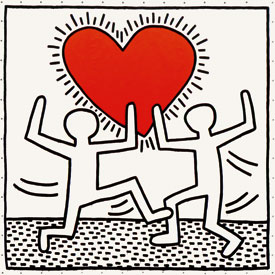Figures With Heart,keith haring heart 1982

This passage describes the theme of "radiating heart-love" that often appears in Keith Haring's paintings and highlights the importance of this theme in his career. It notes that this theme recurs in Haring's work, and that this painting of two men in love is mild compared to his later, more controversial, overtly sexually suggestive images. At the time, the bravery and boldness of expressing gay love was an important statement and notable achievement in the field of culture.

The passage also describes the optimism conveyed by the painting and how Haring was in many ways a romantic who believed in humanity and the power of love. Visually, the painting is typical of Haring's style, including flat two-dimensional surfaces, cartoonish simplicity, and sharp, saturated colors.
In addition, references to characters and scenes in Harlem are often outlined in thick black lines, reminiscent of early modern artists (such as Picasso) and the Pop art movement (such as Warhol), as well as the work of New York City graffiti artists in the 1980s. Haring uses these stark lines to convey a sense of positive and negative energy dynamics around the subject. Some believe that his use of this visual symbol was influenced by hip-hop music, where the visual imagery of the black line is used to represent the impact of sound on the listener.
Finally, this passage highlights how Haring's artwork called for a radical exploration of new cultural possibilities and greatly expanded the understanding of contemporary social issues in society at the time. This passage describes the theme of "radiating heart-love" that often appears in Keith Haring's paintings and highlights the importance of this theme in his career. It notes that this theme recurs in Haring's work, and that this painting of two men in love is mild compared to his later, more controversial, overtly sexually suggestive images. At the time, the bravery and boldness of expressing gay love was an important statement and notable achievement in the field of culture.
The passage also describes the optimism conveyed by the painting and how Haring was in many ways a romantic who believed in humanity and the power of love. Visually, the painting is typical of Haring's style, including flat two-dimensional surfaces, cartoonish simplicity, and sharp, saturated colors.
In addition, references to characters and scenes in Harlem are often outlined in thick black lines, reminiscent of early modern artists (such as Picasso) and the Pop art movement (such as Warhol), as well as the work of New York City graffiti artists in the 1980s. Haring uses these stark lines to convey a sense of positive and negative energy dynamics around the subject. Some believe that his use of this visual symbol was influenced by hip-hop music, where the visual imagery of the black line is used to represent the impact of sound on the listener.
Finally, this passage highlights how Haring's artwork called for a radical exploration of new cultural possibilities and greatly expanded the understanding of contemporary social issues in society at the time.

